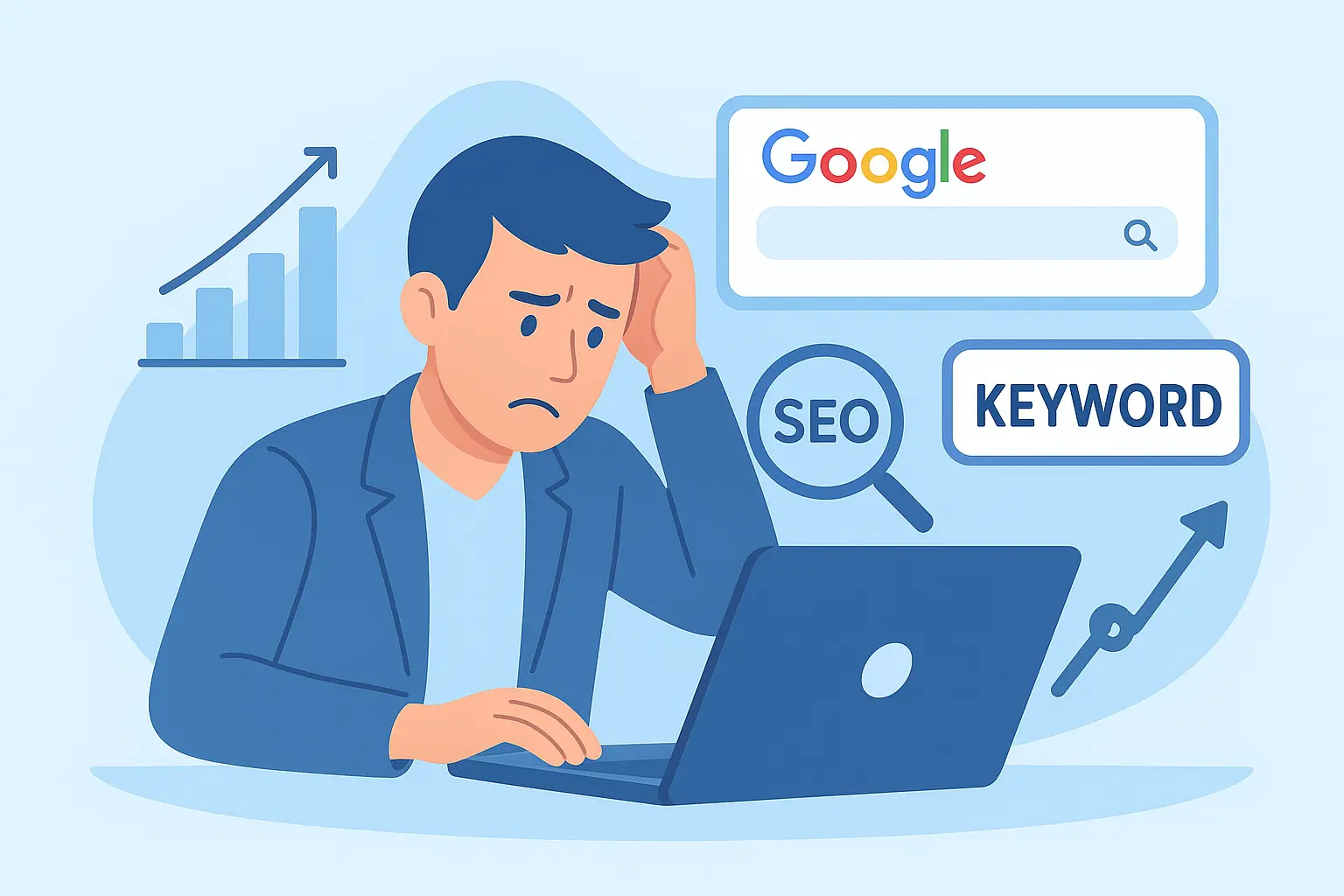Introduction: Why SEO Is the Lifeline of Small Businesses
For small businesses, visibility is everything. Unlike large corporations with massive marketing budgets, small businesses rely on efficient and cost-effective strategies to capture customers’ attention. Search Engine Optimization (SEO) is one of the most powerful tools for building brand visibility, generating leads, and increasing conversions.
However, many small business owners unknowingly commit critical SEO mistakes. These errors not only hinder their growth but also hand over opportunities to competitors. This article explores the seven most common SEO mistakes small business owners make and provides actionable solutions to correct them.
Mistake #1: Ignoring Local SEO Optimization
Local SEO is the backbone of small businesses. When potential customers search for services like “plumber near me” or “best bakery in [city],” Google prioritizes businesses optimized for local search. Surprisingly, many entrepreneurs either skip local SEO entirely or do it half-heartedly.
Why It Hurts
- Failure to claim and optimize your Google Business Profile reduces visibility in Google Maps and the local pack.
- Lack of local keywords in your content and metadata makes it harder for customers to find you.
- No customer reviews = reduced trust and authority.
How to Fix It
- Claim and complete your Google Business Profile (add NAP: Name, Address, Phone consistently).
- Use location-specific keywords in titles, meta descriptions, and blog content.
- Encourage satisfied customers to leave Google reviews, as they directly impact ranking.
- Build citations in local directories like Yelp, Yellow Pages, and industry-specific listings.
Mistake #2: Not Having a Mobile-Friendly Website
More than 60% of online searches are conducted on mobile devices. Yet, many small business websites are still not optimized for mobile users. Google uses mobile-first indexing, meaning if your site isn’t mobile-friendly, it will rank lower.
Why It Hurts
- Poor mobile experience increases bounce rates.
- A non-responsive design damages credibility.
- Slow loading speeds discourage users from staying on the site.
How to Fix It
- Adopt a responsive website design that adjusts to all screen sizes.
- Test mobile usability with Google’s Mobile-Friendly Test tool.
- Compress images and enable caching for faster load times.
- Prioritize simple navigation and clickable buttons for small screens.
Mistake #3: Poor Keyword Research and Overstuffing
Some business owners either target the wrong keywords or stuff too many into their content. Both strategies backfire. SEO today is about search intent, not just sprinkling in popular terms.
Why It Hurts
- Using irrelevant or broad keywords attracts the wrong audience.
- Keyword stuffing makes content unreadable and penalized by Google.
- Lack of long-tail keyword targeting misses conversion-ready customers.
How to Fix It
- Use tools like Google Keyword Planner, Ahrefs, or SEMrush to find relevant keywords.
- Target long-tail keywords (e.g., “affordable wedding photographer in Dallas” instead of just “wedding photographer”).
- Place keywords naturally in titles, headers, and first 100 words—don’t overuse them.
- Focus on semantic keywords that reflect customer intent.
Mistake #4: Neglecting On-Page SEO Elements
On-page SEO is the foundation of every successful SEO strategy, yet many small businesses fail to optimize basic elements.
Why It Hurts
- Missing meta descriptions reduces click-through rates.
- Improper header hierarchy confuses both search engines and users.
- Images without alt text hurt accessibility and image search rankings.
How to Fix It
- Write unique and keyword-rich meta descriptions for each page.
- Use header tags (H1, H2, H3) to structure content logically.
- Add alt text to all images for accessibility and SEO.
- Ensure clean URL structures (e.g.,
yourdomain.com/seo-tips-small-business).
Mistake #5: Forgetting About Quality Content Creation
A static website won’t rank. Google favors websites that consistently produce fresh, valuable, and relevant content. Small business owners often underestimate the importance of content marketing, assuming their homepage is enough.
Why It Hurts
- Lack of content limits opportunities for ranking.
- Without blogs, FAQs, or guides, businesses can’t showcase expertise.
- Competitors who produce content dominate search visibility.
How to Fix It
- Start a blog addressing customer questions and pain points.
- Create how-to guides, tutorials, and case studies to demonstrate expertise.
- Repurpose content into videos, infographics, and social posts.
- Update old content regularly to keep it fresh.
Mistake #6: Overlooking Backlinks and Authority Building
Backlinks are among the top three Google ranking factors, yet many small businesses ignore link-building strategies.
Why It Hurts
- Without backlinks, websites struggle to gain authority.
- Competitors with stronger backlink profiles outrank you easily.
- Lack of industry mentions reduces credibility.
How to Fix It
- Build relationships with local bloggers and influencers.
- Submit guest posts to niche websites.
- Get listed in reputable business directories.
- Create shareable content like infographics and research-based posts.
Mistake #7: Not Tracking SEO Performance and Analytics
SEO isn’t a one-time job—it’s a continuous process. Many small businesses fail because they never measure their progress.
Why It Hurts
- Without data, you can’t identify what works and what doesn’t.
- Wasted time and resources on ineffective strategies.
- Competitors gain an advantage by adjusting based on insights.
How to Fix It
- Install Google Analytics to track user behavior and conversions.
- Use Google Search Console to monitor keyword rankings and site health.
- Track local SEO performance with tools like BrightLocal.
- Set clear KPIs (organic traffic, bounce rate, conversions) and review monthly.
FAQs
Q1: How long does SEO take for small businesses?
SEO is a long-term strategy. On average, small businesses see measurable results within 3–6 months, depending on competition.
Q2: What’s the most common SEO mistake for beginners?
Ignoring local SEO optimization. For small businesses, appearing in local searches is often the quickest path to growth.
Q3: Can I do SEO without hiring an expert?
Yes, you can start with basic SEO practices. However, working with an SEO professional accelerates results and avoids costly mistakes.
Q4: Is content more important than backlinks?
Both are critical. Content builds relevance and trust with users, while backlinks increase authority and ranking power.
Q5: How often should small businesses update their websites?
Websites should be updated regularly—fresh content at least once a month, with technical checks quarterly.
Q6: Do social media signals affect SEO?
Indirectly, yes. While likes and shares aren’t ranking factors, social media drives traffic and amplifies content reach, which can earn backlinks.
Conclusion
SEO is not just about ranking higher—it’s about building trust, authority, and long-term visibility. Unfortunately, many small business owners unknowingly undermine their own efforts by ignoring local SEO, mobile optimization, content creation, and analytics.
The good news is that these mistakes are fixable. By focusing on fundamentals, small businesses can compete with larger brands, attract loyal customers, and grow sustainably online.
👉 For further learning, check out Moz’s Beginner’s Guide to SEO, a comprehensive resource for business owners serious about SEO success.
🚀 Ready to Fix Your SEO Mistakes and Grow Your Business?
I can help you. I’ve already worked with many businesses to improve their SEO, increase online visibility, and achieve measurable results. If you want the same for your business, let’s connect today.
👉 Visit my website: souravlabs.com
📧 Contact me: contact@souravlabs.com
Don’t wait—every day you delay, your competitors get ahead.
Why Digital Marketing is Important for Business: 17 Powerful Reasons You Can’t Ignore


